








Midweek Update 5 October 2023Google Banner Ad THIS WEEK IN MIDWEEK UPDATE New Rolls-Royce engine for hybrid-electric flight completes successful first fuel burn. Oshkosh resident Fred Stadler becomes first to fly 10,000 kids in EAA Young Eagles program. Rotax Fly-In 2023 concludes with a big success. event concept set to go global. Textron Aviation announces confirmed order for first 20 Cessna Grand Caravan EX aircraft from Surf Air Mobility. Joby delivers first evtol aircraft to Edwards Air Force base ahead of schedule. HEAVEN project completes world's first piloted flight of liquid hydrogen powered electric aircraft. Global Combat Air Programme industry partners agree next steps on collaboration to deliver next generation combat aircraft. Airbus unveils PioneerLab as its new twin-engine flying laboratory. This week in History - Dr. Albert Taylor and Leo Young, scientists at the US Naval Aircraft Radio Laboratory, make the first successful detections of objects by "radio observation. Bonus Video - Chapter 322 April 2023 Fly in to Fly Inn Estates 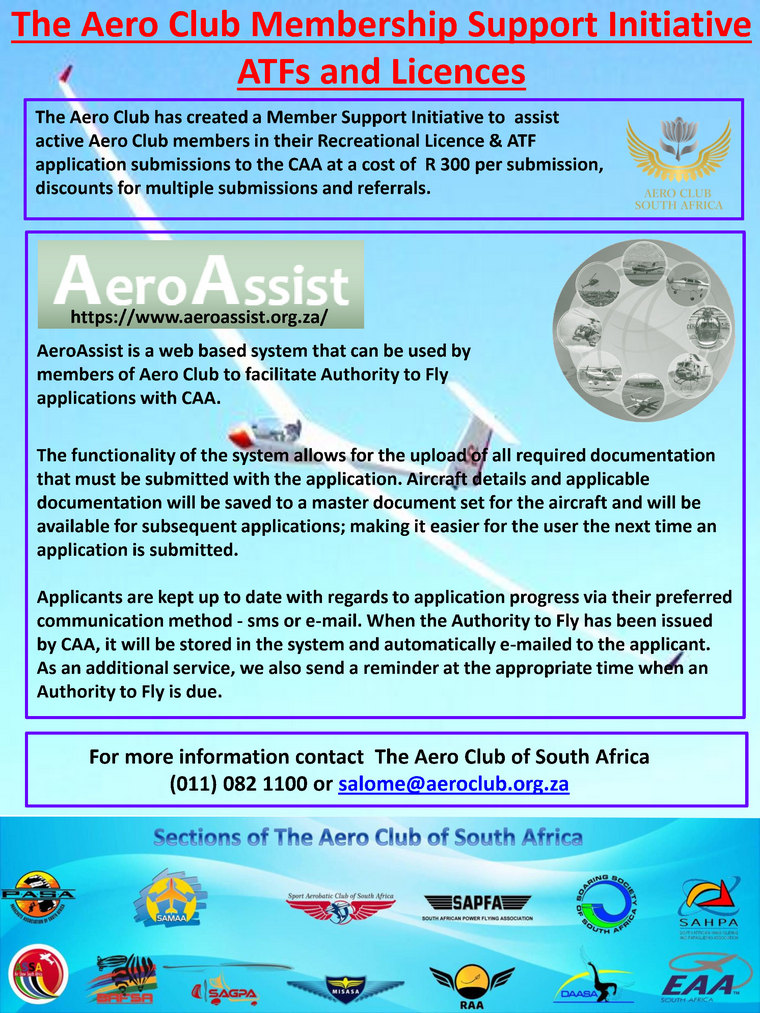 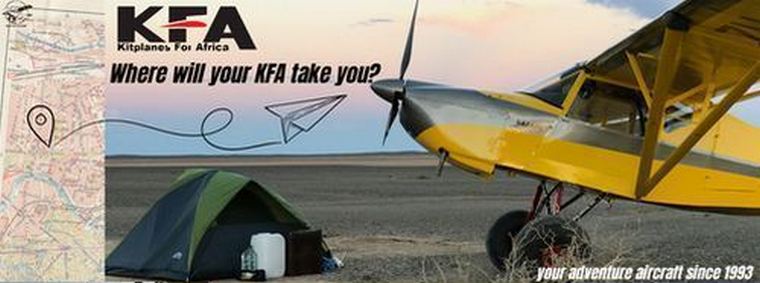   7 EAA Chapter 322 Breakfast Fly In, Auditorium at Rand Aiport. 10 to 12 (Proposed) SAC World Advanced Aerobatic Championships training camp venue TBA. Annie Boon E-mail: info@anniesaviationcorner.com 14 Krugersdorp Flying Club Fly In. RSVP via Whatsapp 083 577 8894 14 to 22 SAC World Advanced Aerobatic Championships training in the USA. Contact Annie Boon E-mail: info@anniesaviationcorner.com 24 October to 4 November. SAC Advanced World Aerobatics Championships Las Vegas. Contact Annie Boon E-mail: info@anniesaviationcorner.com 28 SAPFA SA Landing Championships - Brits & Stellenbosch airfields. Contact Ron Stirk E-mail: melron@mweb.co.za Cell: 082 804 445 0373  4 EAA Chapter 322 breakfast fly-in gathering, boot sale, fly market EAA Auditorium. Contact Neil Bowden E-mail: airadventuresa@gmail.com 4 Brakpan Aero Club Cessna fly-in. Contact Clarissa E-mail: Clarissa@airborneaviation.co.za Cell: 074 113 2911 4 Gyro Fly-In Kitty Hawk Airfield. All aircraft welcome. RSVP Juanita 082 040 9798 11 EAA Chapter 322 breakfast fly-in venue TBA. Contact Neil Bowden E-mail: airadventuresa@gmail.com 13 to 17 Dubai Airshow 2023. Contact: henrietta.fernandes@dubai.aero 18 EAA National & Chapter 322 Annual Awards Dinner Venue TBA. Contact Neil Bowden E-mail: airadventuresa@gmail.com 25 Aero Club Awards 50 Viking Way Rand Airport (Menno Parsons hangar). Contact Sandra Strydom sandra@aeroclub.org.za Tel: 011 082 1100 26 SAA Museum Rand Airport in Memoriam SA 295 Helderberg. For more information call 076 879 5044 or email info@saamuseum.co.ca 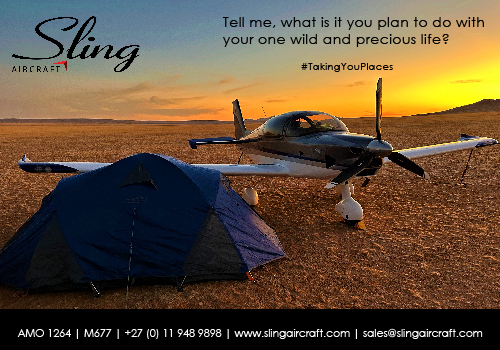 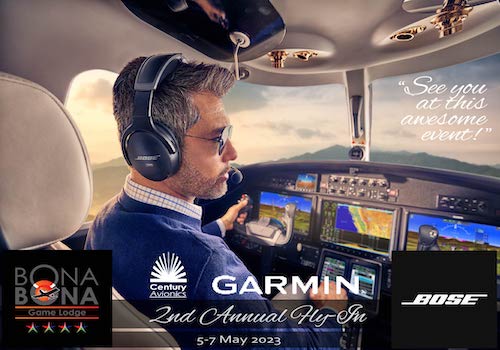  NEW ROLLS-ROYCE ENGINE FOR HYBRID-ELECTRIC FLIGHT COMPLETES SUCCESSFUL FIRST FUEL BURN A new Rolls-Royce small gas turbine that has been specifically developed to power hybrid-electric flight has successfully completed its first fuel burn. The engine has been designed using novel combustion technology to produce ultra-low emissions and this significant achievement confirms the effectiveness of the compact, power-dense turbine that will be integrated into a light-weight turbogenerator system. Matheu Parr, Customer Director, Electrical, said: Rolls-Royce is developing all-electric and hybrid-electric power and propulsion systems for the Advanced Air Mobility market. The first fuel burn of our brand-new small gas turbine is a significant leap forward with successful stages throughout the test from light-up to the pull-away of the system. "This significant achievement follows the fast-paced development time of the new gas turbine from concept freeze to 'pass to test' in under 2 years. The turbogenerator system will enable our customers to extend the routes that electric flight can support and means more passengers will be able to travel further on low and potentially net zero emissions aircraft." The turbogenerator system will complement Rolls-Royce's electrical propulsion portfolio by delivering an on-board power source with scalable power offerings between 500 kW and 1,200 kW enabling extended range on sustainable aviation fuels and later, as it becomes available, through hydrogen combustion. This will open up new, longer routes than electric battery powered aircraft can support today. The development of the turbogenerator solution brings together Rolls-Royce's capabilities in designing compact and lightweight high-speed rotating electric machines, and highly efficient gas turbines combined with the expertise to integrate them on a system and platform level. Test facilities and equipment, comprising 14 subsystems in total, were designed, procured and built - or adapted - by a global team in a record time of just under a year. The test set-up comprises commodity components such as valves and hoses, and bespoke subsystems such as the fuel injection systems, oil and ventilation systems, engine mount and water brake that were tailored to the specific test requirements for this new technology. The first tests helped the team to develop highly relevant knowledge and generate real data to verify key technical attributes of the design. This will allow for design adaptations for the next set of testing, ultimately pushing towards the maturity of a certified engine with world-class performance for this new market segment. Matheu added: With this achievement we have proven we can apply our expertise to novel designs and are able to test them on a very quick timescale. This capability will help Rolls-Royce to deliver the products that will help us on our path to net zero within the ambitious industry timelines of the Advanced Air Mobility market." The turbogenerator can be used in serial or parallel hybrid applications. It is well suited to recharge batteries as well as provide energy to electrical propulsion units directly and therefore enables aircraft to switch between power sources in flight. The research and development of this technology is being partially funded by the German Ministry for Economic Affairs and Climate Action. Rolls-Royce is developing complete power and propulsion systems for all-electric and hybrid-electric applications. Our portfolio features the latest technology, from power generation and energy storage via power electronics and control systems to electric motors.   OSHKOSH RESIDENT FRED STADLER BECOMES FIRST TO FLY 10,000 KIDS IN EAA YOUNG EAGLES PROGRAM Fred Stadler, a longtime EAA volunteer both year-round and at EAA AirVenture Oshkosh, has become the first individual to fly 10,000 kids free of charge as part of the Experimental Aircraft Association's Young Eagles program. Stadler, who began flying young people as part of the program in 2000, reached the milestone on August 26 with a flight at the EAA Aviation Museum's Pioneer Airport.  "Fred's remarkable accomplishment is indicative of the dedication of our Young Eagles volunteers to make a difference and build the future of flight," said Jack J. Pelton, EAA CEO and Chairman of the Board. "There are so many young pilots today who got their start when an EAA-member pilot provided that first flight, igniting a spark that became a career for many. Fred and all those EAA members have earned our congratulations and sincere thanks for their efforts, along with a call for other aviators to join us in flying Young Eagles." Many of Stadler's Young Eagles flights came as a volunteer pilot at the EAA Aviation Museum's Pioneer Airport, a seasonal operation that re-creates the feel of a 1930s airfield. Young visitors can receive a free Young Eagles flight (with parental permission) when they visit the museum during the Pioneer Airport season. In addition to his Young Eagles flying, Stadler is a dedicated EAA volunteer throughout the year. He has also flown Pioneer Airport's Travel Air and Swallow biplanes, becoming the de facto historian on those airplanes. In addition, he volunteers substantial time during AirVenture in the North 40 aircraft camping area and is highly active in EAA Chapter 252 activities in Oshkosh. Stadler and his late wife, Carol, received EAA's Henry Kimberly Spirit of Leadership Award in 2006 for their volunteer efforts by Oshkosh-area residents.  ROTAX FLY-IN 2023 CONCLUDES WITH A BIG SUCCESS. EVENT CONCEPT SET TO GO GLOBAL. This year, the Rotax Fly-In at the Weiße Möwe Wels airfield - close to the BRP-Rotax production facility - played host to more than 130 aircraft and 280 guests, who had come from all across Europe and beyond. It marked one of the best visited years for the event. The highlight of the gathering: the community of aviation enthusiasts coming to-gether and engaging in discussions about technology and their shared passion for flying. The Rotax Fly-In World Tour is set to become a platform inviting all aviation enthusiasts and the curious to join in celebrating the community, exploring, and testing what is new - an aviation festival, so to speak. Just like the Austrian Fly-In, the international events will be informative and entertaining, uphold-ing the quality standards of BRP-Rotax. These events will be organized and hosted by the Independent Service and Distribution Partner Network of BRP-Rotax. The first stop outside Europe will be in Brazil on November 25, 2023. The Fly-In in Wels has already been confirmed for next year as well. "We see ourselves as an integral part of this special community. We are committed to continuing our dialogue with customers in the future, and Fly-Ins provide the ideal setting for such interactions. The success of the Rotax Fly-In in Wels reinforces our decision to expand this event concept international-ly," shared Peter Ölsinger. 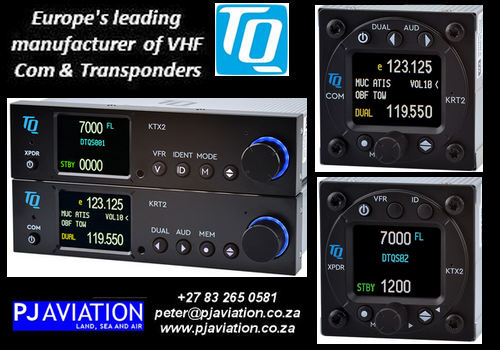 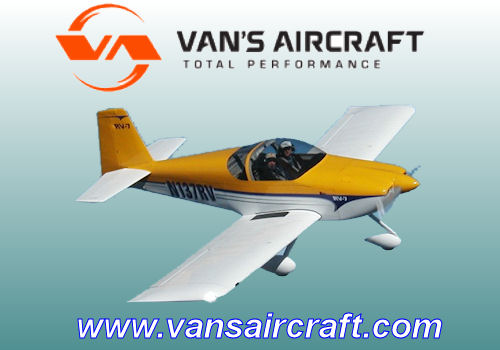 Textron Aviation today announced that Surf Air Mobility Inc. has confirmed its order and paid the deposit for the first 20 Cessna Grand Caravan EX aircraft to be purchased under its previously announced initial fleet order of up to 100 aircraft with options for 50 additional aircraft. Deliveries of the aircraft are expected to begin in the first half of 2024. The anticipated initial fleet delivery demonstrates progress in the exclusive relationship between the two companies supporting Surf Air Mobility's development of an electrified Cessna Grand Caravan EX aircraft. The anticipated initial fleet delivery demonstrates progress in the exclusive relationship between the two companies supporting Surf Air Mobility's development of an electrified Cessna Grand Caravan EX aircraft. (Photo: Business Wire) The anticipated initial fleet delivery demonstrates progress in the exclusive relationship between the two companies supporting Surf Air Mobility's development of an electrified Cessna Grand Caravan EX aircraft. (Photo: Business Wire) The Cessna Grand Caravan EX is designed and manufactured by Textron Aviation Inc., a Textron Inc. (NYSE:TXT) company. Surf Air Mobility has announced its intention that the Cessna Grand Caravan EX single-engine turboprops will be upgraded to Surf Air Mobility's proprietary electric or hybrid-electric powertrain technology. Surf Air Mobility is targeting FAA supplemental type certification in 2026. "We are excited to see Surf Air's progress in expanding their fleet with deliveries expected to begin early next year," said Lannie O'Bannion, senior vice president, Global Sales and Flight Operations. "The Cessna Caravan's adaptability for passenger and cargo operations makes it an ideal platform for hybrid electric and electric propulsion innovations. This exclusive relationship demonstrates Textron Aviation's commitment to the future of sustainable flight." Surf Air Mobility anticipates that the hybrid electric Cessna Grand Caravan EX aircraft will be utilized by Surf Air Mobility across its own network, connecting more airports with short-haul direct service across the U.S. on a path to creating a regional mass transport platform to sustainably connect communities. Surf Air Mobility will also be the exclusive provider to Textron Aviation of certain battery electric and hybrid electric powertrain technology for the Cessna Grand Caravan. "Our relationship with Textron Aviation is paramount in our mission to revolutionize air travel," said Sudhin Shahani, co-founder of Surf Air Mobility. "This initial fleet delivery solidifies our commitment to bringing advanced electric aircraft to market to reduce fuel emissions and the cost of air travel." The Cessna Caravan fleet of more than 3,000 aircraft is certified in 100 countries with more than 24 million flight hours amassed since the aircraft was introduced. Caravan aircraft fulfil roles for multiple missions, ranging from flight training to recreation, commuter airlines to VIP transport, cargo carriers and humanitarian missions. The Cessna Grand Caravan EX was engineered for challenging missions, high payloads and short, rough runways. 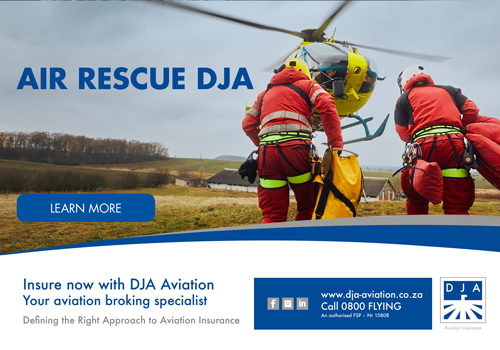  Joby Aircraft becomes first electric air taxi delivered to the U.S. Air Force; believed to be the first electric air taxi delivered in the U.S.; Aircraft will be used to demonstrate logistics missions on base, flown by U.S. Air Force Pilots; delivery is part of Joby's $131 Million Contract with the DOD Joby Aviation, Inc. (NYSE:JOBY), a company developing electric vertical take-off and landing (eVTOL) aircraft for commercial passenger service, today announced it has delivered its first aircraft to Edwards Air Force Base approximately six months ahead of the expected 2024 delivery date. On-base operations with Joby aircraft will be used to demonstrate a range of logistics missions, including cargo and passenger transportation, and will be operated by both Joby and U.S. Air Force personnel. In partnership with the U.S. Air Force, NASA will also use the aircraft for research focused on how these aircraft could fit into the national airspace, benefiting the entire air taxi industry. Joby's aircraft, which has already begun flying at Edwards AFB, is the first electric air taxi to be stationed on a U.S. military base and is believed to be the first delivery of an electric air taxi in the U.S., as part of Joby's $131 million AFWERX Agility Prime contract with the U.S. Air Force. Joby's current and previously completed work with the Department of Defence represents a total potential contract value of $163 million, the largest in the industry. The Agility Prime contract includes the provisioning of up to nine aircraft to the U.S. Air Force and other federal agencies, reinforcing the U.S. government's continued leadership in developing and adopting eVTOL technology, and ushering in a new era of electric aviation. A second aircraft is planned to be delivered to Edwards in early 2024. The aircraft, which was the first built on Joby's Pilot Production Line in Marina, CA, will be stationed at Edwards Air Force Base for at least the next year, with charging and ground support equipment provided on-base by Joby in a facility purpose-built by the Air Force for joint flight test operations. The U.S. Air Force and Joby will conduct joint flight testing and operations to demonstrate the aircraft's capabilities in realistic mission settings. On-base operations will also include the training of Air Force pilots and aircraft maintenance crews, which will provide the DOD with valuable insight into the performance of eVTOL aircraft and will give Joby on-the-ground operational and training experience as the company prepares for the launch of commercial passenger service in 2025. Joby's partnership with the DOD dates back to its 2016 engagement with the Defense Innovation Unit (DIU), which granted the company early funding as well as access to test ranges and expertise that have aided its aircraft development program. Over the past year, the U.S. Air Force and Marines have made multiple visits to Joby's manufacturing and flight test facilities in Marina, CA. Four U.S. Air Force pilots completed full remotely-piloted transition flights of the Joby aircraft in April, and two groups of Marines visited in May to conduct mission analysis regarding potential logistics and medical applications of the aircraft. With a range of up to 100 miles plus energy reserves and a top speed of 200 mph, the Joby aircraft is capable of transporting a pilot and four passengers quickly and quietly with zero operating emissions.   Project HEAVEN, a European-government-supported consortium assembled to demonstrate the feasibility of using liquid, cryogenic hydrogen in aircraft, today announced it has successfully completed the world's first piloted flight of an electric aircraft powered by liquid hydrogen. The consortium is led by H2FLY and includes the partners Air Liquide, Pipistrel Vertical Solutions, the German Aerospace Centre (DLR), EKPO Fuel Cell Technologies, and Fundación Ayesa. Results of the test flights indicate that using liquid hydrogen in place of gaseous hydrogen will double the maximum range of the HY4 aircraft from 750 km to 1,500 km, marking a critical step towards the delivery of emissions-free, medium- and long-haul commercial flights. "This achievement marks a watershed moment in the use of hydrogen to power aircraft. Together with our partners, we have demonstrated the viability of liquid hydrogen to support medium and long-range emissions-free flight," said Professor Josef Kallo, co-founder of H2FLY. "We are now looking ahead to scaling up our technology for regional aircraft and other applications, beginning the critical mission of decarbonizing commercial aviation," he added. Beside project HEAVEN, the work has been funded by the German Federal Ministry for Economic Affairs and Climate Action (BMWK), the German Federal Ministry for Digital and Transport (BMVD), and The University of Ulm. Compared with pressurized gaseous hydrogen storage (GH2), the use of liquified, cryogenic hydrogen (LH2) enables significantly lower tank weights and volume, therefore leading to increased aircraft range and useful payload. Pierre Crespi, Innovation Director at Air Liquide Advanced Technologies says: "Air Liquide is proud to have designed, manufactured and integrated, together with H2FLY, the liquid hydrogen tank that enabled to power the HY4 aircraft. Today's success demonstrates the full potential of liquid hydrogen for aviation. Liquid hydrogen can be stored onboard and transported. Hydrogen is key to the energy transition and this new step proves that it's already becoming a reality." Dr. Syed Asif Ansar, Head of Department Energy System Integration at the German Aerospace Centre (DLR), says: "DLR boasts extensive expertise in electrified aircrafts, with a track record spanning over 15 years. Starting from the inaugural flight of the Antares DLR-H2 in 2009, consistent advancements have been made in fuel cells and their auxiliary systems. This progressive journey culminates in a significant present achievement in aviation history: the utilization of cryogenic liquified hydrogen as fuel storage for a four-seater aircraft powered by fuel cells. Collaborating with H2FLY, AirLiquide and other project members, DLR is actively engaged in projects aimed at propelling the development of CS-23 and CS-25 fuel cell powered aircraft into the next phase." Tine Tomažic, head of engineering and programs at Pipistrel, says: "To be a part of this magnificent team has been an honour. At Pipistrel, our aim is to be the pioneer of future flight and playing a role on the liquid hydrogen tank integration, we, along with all the other partners involved, are able to demonstrate the success of alternative sustainable fuels, ready to power the aircraft of tomorrow." With the completion of the flight testing in project HEAVEN, H2FLY will focus on the path to commercialization. In June, H2FLY announced the development of its new H2F-175 fuel cell systems which will be capable of providing their full power range in flight altitudes of up to 27,000 ft, marking an important step on the path from lower altitude viability flight demonstrations to real-world commercial aircraft applications. In 2024, H2FLY will open its Hydrogen Aviation Centre at Stuttgart Airport, co-funded by the Ministry of Transport Baden Württemberg. The Centre will become a focal point for the future of Europe's aviation industry and its hydrogen economy, providing fuel cell aircraft integration facilities and liquid hydrogen infrastructure. 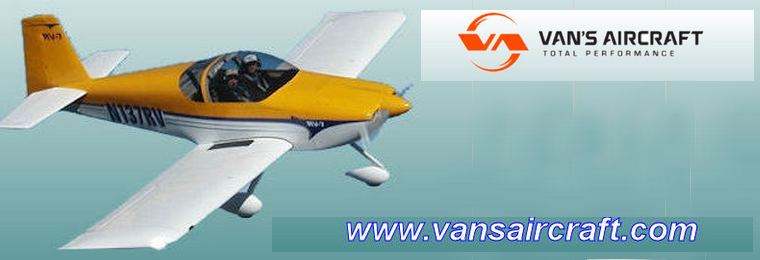 GLOBAL COMBAT AIR PROGRAMME INDUSTRY PARTNERS AGREE NEXT STEPS ON COLLABORATION TO DELIVER NEXT GENERATION COMBAT AIRCRAFT Defence industry leaders in the UK, Japan and Italy have agreed a trilateral Collaboration Agreement to deliver the concept phase requirements of a next generation combat aircraft for the Global Combat Air Programme (GCAP). The agreement between BAE Systems (UK), Mitsubishi Heavy Industries (Japan) and Leonardo SpA (Italy) reflects positive momentum and strong trilateral cooperation, and will involve the industry partners maturing integration, collaboration and sharing of information towards the next phase of GCAP. The Collaboration Agreement supports ongoing discussions to set out long-term working arrangements and maturity of the concept and capability requirements for the next generation combat aircraft. Herman Claesen, Managing Director, Future Combat Air Systems, BAE Systems, said: "We have maintained a high tempo of engagement with our industrial and government partners in Italy and Japan since the launch of GCAP. The Collaboration Agreement signals the strong alignment across all three nations to meet common goals and objectives on the programme to deliver a truly international, next generation combat aircraft." Guglielmo Maviglia, Director GCAP Programme, Leonardo SpA, said: "This trilateral collaboration on the programme, for the development of a next generation system, represents the flagship of the distinctive capabilities and disruptive technologies that the partners of the three nations will share, in an innovative way, for the success of the programme. Participation in DSEI London fits perfectly into our progress of the collaboration and consolidates more than ever the strong ties created between the partner companies of Italy, the UK, and Japan. In this context, we are particularly proud to be able to contribute to the future and the prosperity of the generations to come with significant implications for security and technological development, as well as in the field of research and innovation in the aerospace and defence sectors." Hitoshi Shiraishi, Senior Fellow, GCAP, Mitsubishi Heavy Industries, said: "We are truly honoured to be part of GCAP and will bring all of our considerable knowledge accumulated through previous programmes to the table. The Collaboration Agreement is one of the key steps to ensure our mutual success. We have already started cooperating closely with our UK and Italian partners and believe that our mix of cultures and diverse perspectives will contribute to the success of this programme." GCAP is a hugely significant programme for the security, political and economic prosperity of each nation and through effective knowledge and technology transfer will help to evolve and deliver important sovereign combat air capability in each nation for generations to come. 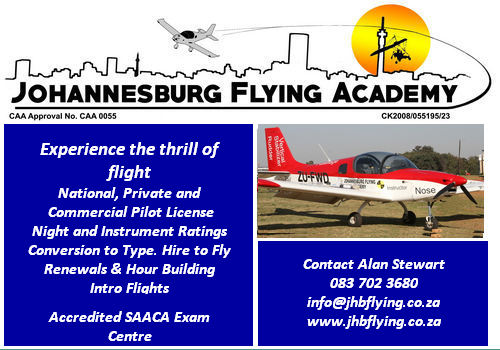 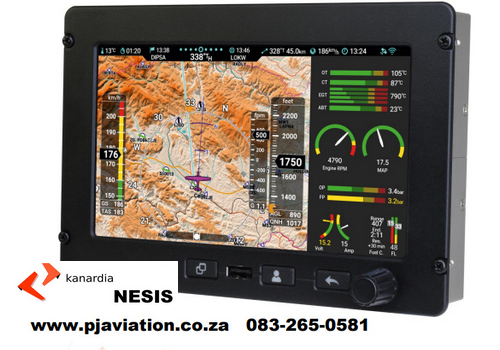 During the German National Aviation Conference in Hamburg, Airbus Helicopters unveiled the PioneerLab, its new twin-engine technology demonstrator based on the H145 platform. It complements Airbus' range of FlightLabs and focuses on testing technologies that reduce helicopter emissions, increase autonomy and integrate bio-based materials. "With PioneerLab, we continue our ambitious strategy to test and mature new technologies on board our helicopter demonstrators," said Tomasz Krysinski, Head of Research and Innovation Programmes at Airbus Helicopters. "PioneerLab, which is based in Germany at our Donauwörth site, will be our platform to test technologies specifically dedicated to twin-engine helicopters." 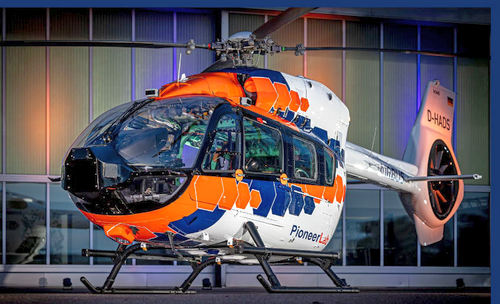 The company intends to produce the new parts using processes that reduce material and energy consumption and improve recyclability. Further research activities will include the integration of the latest digital technologies into the aircraft's flight control system and associated sensors to increase autonomy and safety during critical flight phases such as take-off and landing. PioneerLab is partially co-funded by the BMWK, the Federal German Ministry for Economic Affairs and Climate Actions through its national research program LuFo. Airbus Helicopters' FlightLabs provide agile and efficient test beds to quickly test technologies. They are part of the company's strategy to bring incremental innovation to improve its current products and as well as to mature technology for future platforms. The PioneerLab's flight campaign has already begun at the manufacturer's largest German site in Donauwörth, with a rotor strike alerting system being the first techno-brick tested on board the demonstrator. The next phase will be to test an automated take-off and landing system. 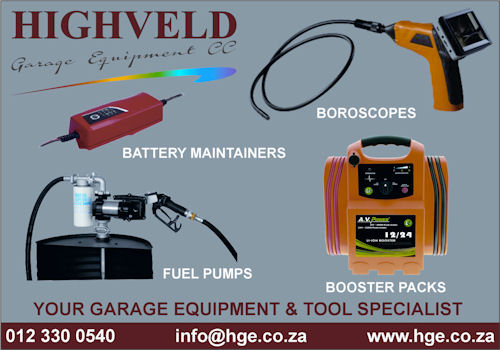 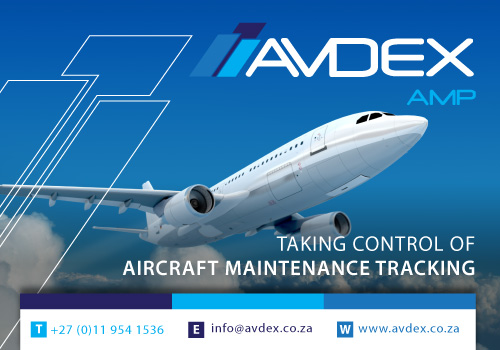  USA, Lake Winnipesaukee, N of Ellacoya State Park, near Gilford, NH: A Cessna 150K impacted the waters of Lake Winnipesaukee, N of Ellacoya State Park, near Gilford, New Hampshire, while on approach to Laconia Municipal Airport (LCI/KLCI), Gilford. The sole pilot died and was found one day later and the aircraft was destroyed. ADS-B data suggests the pilot was lining downwind over Lake Winnipesaukee. The airplane began a descending right spiral towards the water and was lost from radar. France, Carpentras Airfield (LFNH), Pernes-les-Fontaines: An amateur built Pietenpol Air Camper started to move on its own and ran away after hand propping (starting the engine by swinging the propeller) without pilot or competent person at the controls or being tied to an object, it subsequently crashed into the Aero club's building. Nobody was on board, the aircraft received substantial damage. USA, near Whitesville, KY: A Piper PA-28-161 Warrior II, N3079M, was destroyed when it was involved in an accident near Whitesville, Kentucky. The flight instructor and student pilot sustained fatal injuries. Preliminary information indicates that there were thunderstorms passing through the area of Whitesville around the time of the accident. A review of Snapchats videos posted by the instructor reportedly shows that the CFI called the student "slow, like Forrest Gump Jr" in one of the earlier videos and complained about the fact he "had to be up early the next morning". On the day of the accident, the CFI posted a screenshot of the weather data during flight and commented "Headed our way are storms like a group of pissed of hornets". Greece, off Achladi beach, North Evoia, Euboea Island: An Agusta A109 helicopter crashed just offshore from Achladi beach, Greece, in poor visibility conditions. The aircraft was on a visual flight from Afidnes to Volos, with a stopover in Mantoudi. The pilot (69) was found dead at sea. He was a retired air force officer and one of the most experienced military helicopter pilots in the air force. New Caledonia, Nouméa-Magenta Airport, Nouméa: A CSA PS-28 Cruiser suffered a nose landing gear collapse while landing at Nouméa-Magenta Airport (GEA/NWWM), Nouméa. There were no personal injuries and the aircraft received minor damage.    27 SEPTEMBER 1922 Dr. Albert Taylor and Leo Young, scientists at the US Naval Aircraft Radio Laboratory, make the first successful detections of objects by "radio observation". They use wireless waves to detect objects not visible due to weather or darkness. This insight leads to the advent of radar.  On March 13, 1917, Taylor was appointed Lieutenant, US Naval Reserve Force, Provisional and assigned to the 9th, 10th and 11th Naval Districts, Great Lakes, IL. Upon the outbreak of the war, he was assigned duty as District Communications Officer, Ninth Naval District, Goat Lake, Ill. He was Director, Naval Communications, Washington, D.C., until 17 Oct. 1917. He was Communication Superintendent, Naval Radio Station, Belmar, NJ, until 25 July 1918. On 14 Nov. 1918. He resigned from active Navy duty in 1922, but remained as a civilian employee. In the fall of 1922, Taylor and Leo C. Young were conducting communication experiments at the Aircraft Radio Laboratory when they noticed that a wooden ship in the Potomac River was interfering with their signals; in effect, they had demonstrated the first continuous wave (CW) interference detector. The next year the U.S. Naval Research Laboratory (NRL) was founded and Taylor became head of its Radio Division. In the early 1930s, the idea of pulsing a transmitter to provide both detection and range measurement occurred to Taylor and Young, as it had to German and British scientists. Taylor instructed an assistant, Robert Morris Page to construct a working prototype; this was demonstrated in December 1934, detecting an airplane at a distance of one mile. By 1937, his team had developed a practical shipboard radar that became known as CXAM radar, a technology very similar to that of Britain's Chain Home radar system. Taylor remained at NRL until his retirement in 1948. He died in 1961, a few weeks before his 83rd birthday.  Chapter 322 April 2023 Fly in to Fly Inn Estates 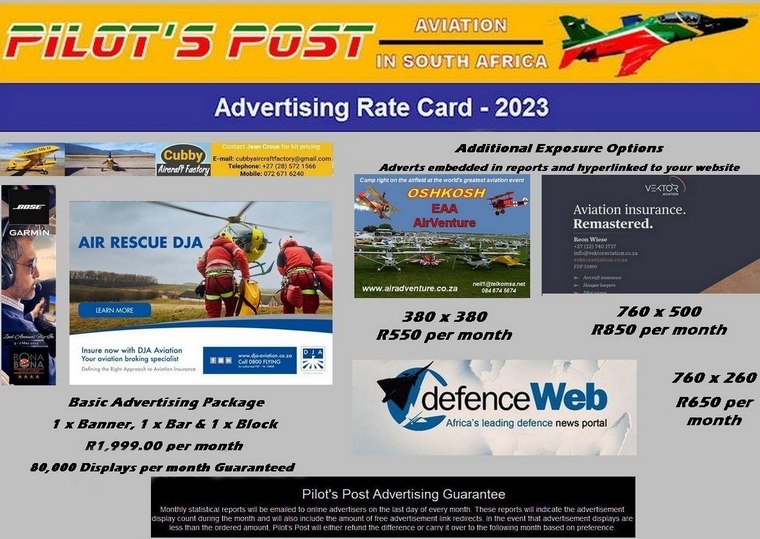 Google Banner Ad |
                            |
 |
 |

Copyright © Pilot's Post PTY Ltd
The information, views and opinions by the authors contributing to Pilot's Post are not necessarily those of the editor or other writers at Pilot's Post.